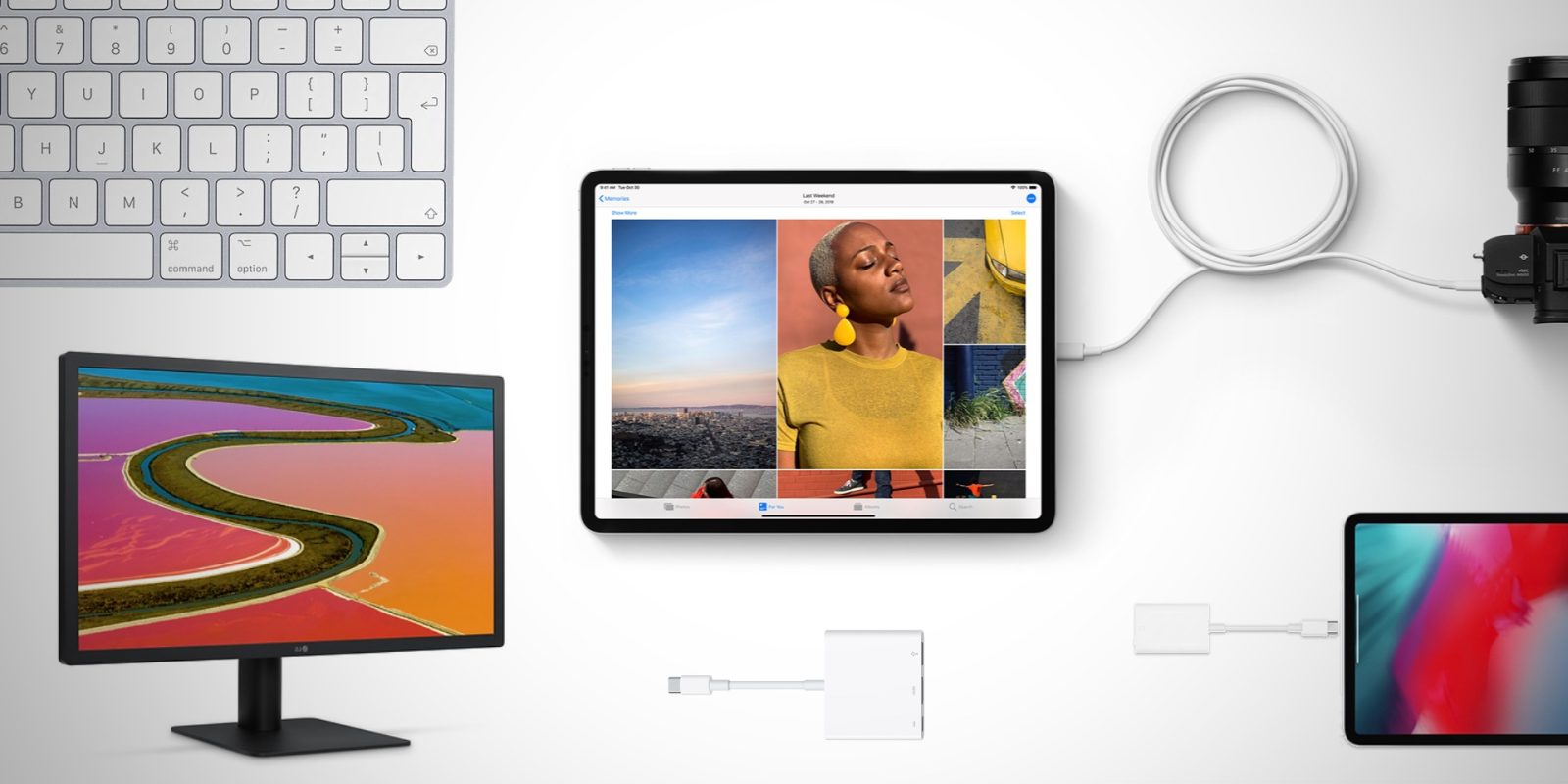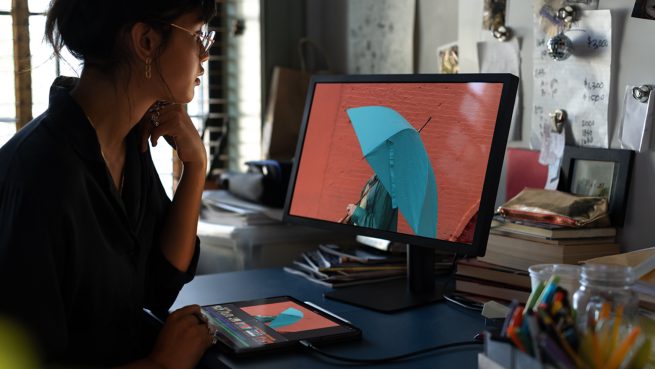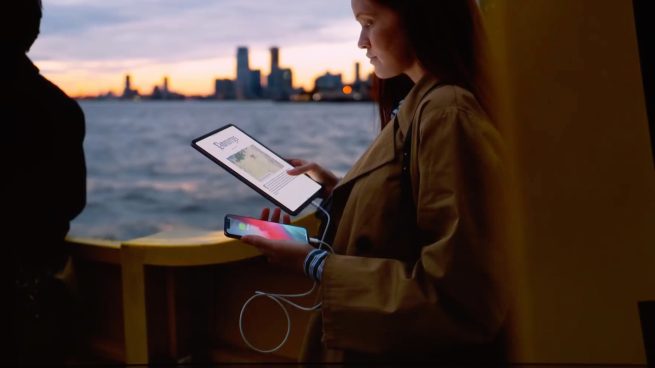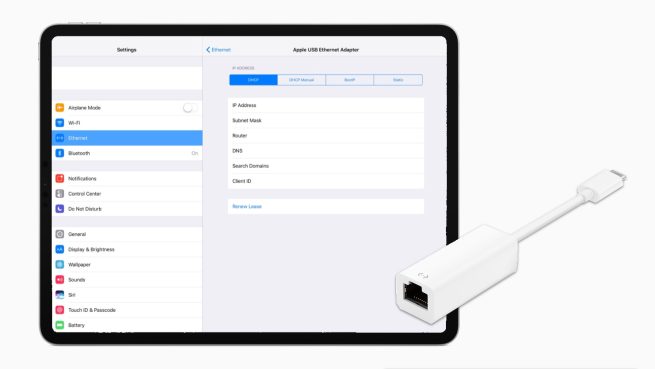
[ad_1]
The new 11-inch and 12.9-inch iPad Pro features a USB-C port instead of a Lightning port. However, just because a device features a new port, it does not mean anything with a USB-C connector will suddenly work with the iPad Pro. There are still some limitations but USB-C makes it even easier to connect to external displays, cameras, and other accessories.
Here’s what you can do with your new iPad Pro and its shiny new port …

Try Amazon Prime 30-Day Free Trial
The USB-C connector serves many duties. On Apple’s laptops, all USB-C ports are Thunderbolt 3 ports (except on the 12-inch MacBook) which enables insanely-fast bandwidth and throughput, with the ability to drive multiple displays and a whole plethora of connectivity off a single port.
The iPad Pro does not have Thunderbolt. It has a USB-C 3.1 Gen 2 port. This means it can drive a maximum of 10 gigabits per second, which makes it possible for the iPad to drive a 5K monitor at 60 frames per second. However, there is a catch.
In fact, there are little asterisks and gotchas to be aware of for almost anything relating to the iPad Pro’s new USB-C. Let’s break it down.
Connect external displays

The new iPad Pro can connect directly to USB-C displays, that communicate over the DisplayPort standard. You can plug a USB-C cable into the iPad on one end and an external monitor with a USB-C port on the other, like the 4K LG UltraFine display. The iPad supports HDR10 output, so it can take full advantage of high-dynamic range displays where available, like the 27-inch LG 27UK850.
The iPad will mirror the screen, and some apps take special advantage of the additional screen output. For example, Keynote will show the live presentation on the external display and speaker’s notes on the iPad. You could connect to a TV to show your Netflix movies on the big screen, for instance. Just be aware that it is not as flexible as when you connect a second display to a Mac.
What’s a little annoying is you cannot use the USB-C cable that comes in the box with the iPad. You need a USB-cable that supports ‘high-bandwidth’ connections. This includes the USB-C cable that will have come with the display. If you don’t have. a cable handy, confusingly, Apple will suggest buying a Thunderbolt 3 cable from the Apple Store to do this. You can get this one from Belkin for $10. Even though the iPad does not support Thunderbolt, the cables are backwards compatible with the high-bandwidth USB-C.
The iPad can output to 5K displays. However, the LG 5K UltraFine display that Apple sells is not compatible. Why? It has a USB-C connector but it is a Thunderbolt 3 display. The iPad does not support Thunderbolt. 5K USB-C displays are really scarce at the moment and we don’t have any good recommendations just yet.
If you want to connect to a display that does not have a USB-C port, like HDMI, you will need to use some kind of dongle or adapter. The iPad Pro can use an adapter to output using the HDMI 2.0 spec, which supports a max resolution of 4K at 60Hz, and can theoretically output HDR10 and Dolby Vision with compatible adapters (although none seem to be available yet).
The Apple dongle for HDMI is the Apple USB-C Digital AV Multiport Adapter. This plugs into the iPad Pro USB-C port and adds a HDMI out, a passthrough USB-C port for power, and a standard USB-A port. The Apple adapter outputs 4K at 30Hz. You can even get USB-C to VGA adapters if you need to connect to old-school projectors or similar.
Charging other devices

The USB-C port on the iPad Pro can power connected devices up to 7.5 W charging speeds. If you have a USB-C to Lightning cable, you can plug in your iPhone and charge your iPhone with your iPad. If you have two new iPad Pros, you can use the included USB-C to USB-C cable to connect them together and charge the other. One iPad will take power from the other at a time.
Third party USB accessories can also receive up to 7.5 W of power, just plug them in. If you have a USB-A accessory, you can buy a USB-C to USB-A dongle.
Apple recently released a USB-C cable for the Apple Watch, so you can even charge your Apple Watch on the go, no intermediary dongles, just sipping your iPad’s beefy battery.
Import photos and videos from external storage

The iPad does not support generic external storage. You cannot plug in a USB-C flash drive and see the files in the Files app. This is an operating system limitation that many expect Apple will address in a future software update, but it is not possible today.
However, you can use the Photos app to import photos and videos from USB storage. If you happen to have a bunch of photos on a USB hard drive, you can connect it to the iPad and use the Import tab in the Photos app to suck in photos and videos.
This also works with cameras. Many cameras feature USB-C or mini-USB ports. As long as you have the appropriate adapter or cable, like this $6 USB-C mini-USB cable, you can shoot with your camera and immediately connect it to the iPad to import the files and see your photos on the big screen.
The same is true for SD card import. Apple now offers its own USB-C to SD Card reader. Plug it into the iPad Pro and insert an SD card and it will enable photos and video import. It even supports fast transfers with UHS-II cards. As USB is an open standard, you can find cheaper SD card USB-C dongles if Apple’s official offerings are too pricey.
Connect hardware keyboards and wired internet

The iPad has drivers for many basic types of USB accessories. iOS doesn’t let you install additional drivers but it has support for a surprising number of basic external devices that you would plug-and-play with a computer.
For example, hardware keyboards will just work. If you have a USB-A keyboard, you can use a USB-C adapter and plug it in and the iPad should detect it and you can type away to your heart’s content. Of course, Apple would prefer you to use Bluetooth keyboards or the Apple Smart Keyboard Folio.
Another thing the iPad supports is Ethernet, so your iPad can actually use wired networking if you can’t use WiFi. You can get a USB-C Ethernet dongle and hardwire gigabit Ethernet to your iPad Pro. The iOS Settings screen will magically show a new section for Ethernet, when it is detected.
Connect to speakers, microphones or audio MIDI devices
The iPad does not have a headphone jack. You can use the $9 Apple USB-C to headphone jack adapter to plug into wired headphones or speakers. If you have USB-C headphones, they will plug in directly and just work.
You can also connect audio devices like MIDI keyboards, or microphones, using USB. In some cases, the 7.5 watts the iPad outputs over the port will be enough to power smaller accessories, so all you need is a USB-C cable. Accessories that need more power will work as long as the USB bus has sufficient power draw. Use apps like GarageBand to communicate with MIDI accessories.
One way to achieve this is to use the Apple USB-C Digital AV Multiport Adapter. Ignore the HDMI output, connect power to the passthrough USB-C port on the adapter and plug the accessory into the standard USB port. The accessory will then draw power through the USB-C charging.
Connect multi-port hubs
As the finale, the USB-C bandwidth is high enough that you can drive multiple accessories at a time through the single port. You can mix-and-match all of the above — photos import, displays, microphones, etc — at the same time. You just need an appropriate hub and there are loads to choose from on the market. Here’s a cheap and cheerful one for $20 that offers SD card reader, a micro-SD card reader and 3 USB-A ports. As always, how much you can connect at once is limited by the available power throughput. The Apple USB-C Digital AV Multiport Adapter is essentially a hub in itself, offering HDMI, power input, and a spare USB-A port for accessory connectivity.
Much of this was possible with previous iPads, but would always necessitate the use of adapters. Dropping Lightning for USB-C opens up the iPad to a whole world of peripherals that can be connected directly. The extra bandwidth of USB-C also enables some things you simply couldn’t before. You can now connect up to a 4K display and a camera at the same time, or a single 5K display at 60Hz refresh rate. 7.5 watt charging out is also brand new.
Source link